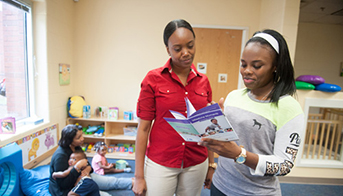Developmental Milestones Resources for Home Visiting Programs
CDC’s milestones and parent tips have been updated and new checklist ages have been added (15 and 30 months). For more information about the updates to CDC’s developmental milestones, please review the Pediatrics journal article and these important key points.

FREE resources from the Centers for Disease Control and Prevention (CDC) to help you engage families in monitoring children’s developmental milestones from 2 months to 5 years of age.
CDC’s Learn the Signs. Act Early. materials help you…
- Meet home visiting performance indicators because they
- Complement and support developmental screening
- Enhance individualized developmental support
- Help with making referrals
- Help parents better understand their child’s development
- Communicate with parents about their child’s progress
- Guide parents when there is a concern about their child’s development
1 in 6 children has a developmental delay or disability. You can help identify children with signs of developmental delay, strengthen family engagement, and better support children by…
- Supplementing your curriculum with CDC’s Learn the Signs. Act Early. parent education and engagement materials
- Enhance developmental screening by using milestone checklists [4 MB, 24 Pages, 508] and the Milestone Moments booklet [3 MB, 60 Pages, 508] to track each child’s development between screenings.
- Help parents understand age-appropriate milestones by showing pictures and videos from Milestones in Action.
- Share children’s books Amazing Me and Where is Bear? to help parents learn about developmental milestones while reading with their child.
- Increase your knowledge of signs of potential delay and what to do if there is a concern.
- Encouraging parents to use the Milestone Tracker app and review the My Child’s Summary page with you to facilitate communication about developmental progress.
- Helping parents take action on developmental concerns by sharing CDC’s How to Get Help for Your Child [727 KB, 2 Pages, 508] tip sheet.
What Home Visitors Are Saying!

“My clients enjoy looking for their babies’ milestones. They use the booklet to “glimpse into the future” of what their babies will be doing next! It allows them to prepare for what is to come even after they have graduated from our program.”
– Nurse Home Visitor, South Carolina
It’s Working in Home Visiting!
Help Me Grow South Carolina and Maternal, Infant, and Early Childhood Home Visiting (MIECHV) programs have developed a model to successfully integrate Learn the Signs. Act Early. materials.
The model includes
- An engaging training on developmental milestones for families.
- Discussions with families at each visit about their child’s development, using materials like CDC’s Milestone Moments booklet [3 MB, 60 Pages, 508].
- A process to refer children to appropriate providers for further evaluation if parental concerns arise during visits.
Resources
Brazelton Touchpoints Development is a Journey Roadmap
This roadmap is designed for home visitors to facilitate conversations if there are developmental concerns and/or after developmental screening using seven short and simple steps to actively engage parents and other caregivers in planning for their child’s developmental needs and enhance the provider-parent partnership.
Development is a Journey conversation roadmap PDF | Roadmap Background and Guidance

